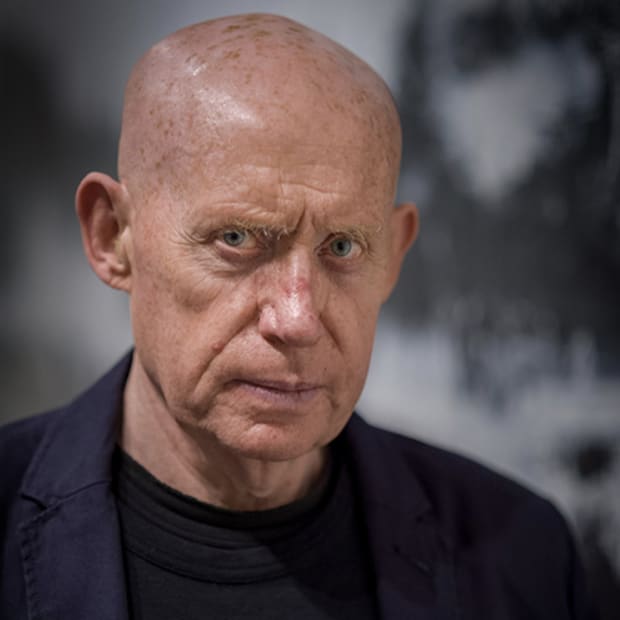John Virtue (Paintings) British, b. 1947
-
OverviewVirtue's blacks and whites aren't polarised absolutes: they drip and smear each other with gleeful impurity, much of the white flecked with a kind of metropolitan ashiness that gives the paint guts and substance, much of the black, streaky and loose, like road tar that refuses to set.
Simon SharmaJOHN IS AN MA GRADUATE OF THE SLADE SCHOOL OF ART
Now in his seventies, John Virtue is considered one of the most distinguished painters working in the United Kingdom today. His work is included in the collections of TATE, London, Walker Art Center, Minneapolis, Yale Center for British Art, New Haven, British Museum, Victoria and Albert Museum, Government Art Collection (UK), Arts Council of England and The Courtauld Institute. He is a painter whose work rides a fine line between figuration and abstraction.
For the last fifty years, Lancashire, the Exe estuary in Devon, London, the Italian landscape and the North Norfolk coast have been the subject of intense ritualistic scrutiny, always rendered in black and white.
In 2003, he became the sixth associate artist at The National Gallery, London, a scheme that allowed an invited contemporary artist to connect with the collection to produce work inspired by the Old Master tradition. Culminating in 2005, a group of monumental London skyline paintings were exhibited at this flagship public institution.In 2009, John moved from Italy to North Norfolk, where he wrestled with the enormity of the sea, sky, and weather around Cley-next-the-Sea and Blakeney Point. Since 2020, he has worked from a studio in Hertfordshire.
His work has been deeply influenced by giants of the past, such as John Constable, Samuel Palmer, and J M W Turner, as well as twentieth-century greats Franz Kline, Robert Ryman and Jackson Pollock. Japanese calligraphy has also left a profound mark on his painting, a testament to his admiration of Ike no Taiga (Edo period) and Sengai Gibon (Rinzai School).
In 2019, a monograph covering over forty years of John's work was published by ALBION Ridinghouse. This two-hundred-and-eighty-five-page illustrated book provides a substantial overview of the development of Virtue's art. It traces his close relationship with locations in Devon, Exeter, London, Italy and Norfolk. The critical text is provided by Paul Moorhouse, Ex TATE and previously, Senior Curator, 20th Century Collections, National Portrait Gallery.
The gallery has work from all periods of the artist's oeuvre. If you are thinking of buying or selling, please get in touch.
Please email the gallery for information about works currently for sale. -
WorksOpen a larger version of the following image in a popup:
 Photo by Bill Mudge
Photo by Bill Mudge
John Virtue (Paintings) British, b. 1947
Untitled No.27, 2019-20Signed, titled and dated on the reverseAcrylic on canvas
Unframed6 x 6 in | 15.2 x 15.2 cmPrivate Collection
Essay by Paul Moorhouse
Art historian and curator. From 2005-17, Senior Curator of Twentieth-Century Collections and Head of Displays (Victorian to Contemporary) at the National Portrait Gallery, London.
John Virtue by Paul Moorhouse, a monograph covering over forty years of John's work, was published in 2019 by ALBION Ridinghouse. Paul Moorhouse has been closely associated with the artist for over twenty years and has written extensively on his work. In this lavishly illustrated book, he discusses the development of Virtue's art from its beginnings and traces the artist's close relationship with locations in Lancashire, Devon, Exeter, London, Italy and Norfolk. As Moorhouse shows, these places have each generated a fresh artistic response, forming distinct episodes in an overarching vision. This is rooted in the landscapes that Virtue observes but also in deeper aspects of experience. For in Virtue's art, the passage of time, mortality, and a will to express the intensity of each lived moment are abiding themes.
In 1978 John Virtue had been living in Green Haworth, a remote Lancashire village, for seven years. During that time, he had struggled to find a way forward as an artist and had become discouraged by a growing sense of failure. Finally, he decided to destroy all his previous work. This destruction was to prove a liberation. In April that year, he resolved to 'try and become a real artist'. It was a memorable turning point. He decided that the surrounding landscape would form his subject and that in his response to it, there would be no equivocation. Eliminating brushes, colour, paint and canvas - all of which seemed extraneous to the direct means of expression he was seeking - he began again by making small pencil or charcoal drawings during regular walks. These images, he decided, would unfold like a visual diary. With this pledge, Virtue determined the course of his art. It commenced a journey that continues to the present day.
During the ensuing four decades, Virtue has forged a distinctive artistic path. Drawings made in the landscape have continued to be the primary source for larger works created in the studio. There, the images preserving his original experiences yield a second phase of imaginative and expressive engagement that goes far beyond each observed motif. Combining walking, drawing, abstraction and radical improvisation, Virtue's dynamic process has produced a body of work that extends the tradition of landscape painting in unprecedented ways. Today, Virtue is widely regarded as one of Britain's leading painters.

Video
-

The Glance and the Gaze
John speaks about his work at a TED x Courtauld Institute Event, 2018 -

John Virtue and the Sea
2015 Solo exhibition at the Towner Art Gallery, Eastbourne -

Towner Art Gallery Discussion
John Virtue and Andrew Graham Dixon in conversation at the Towner Art Gallery, Eastbourne during Virtue's 2015 exhibition, John Virtue : The Sea. Andrew Graham Dixon is an award-winning art... -

The Culture Show
A PORTRAIT OF JOHN VIRTUE PRIOR TO HIS EXHIBITION, 'LONDON PAINTINGS', AT THE NATIONAL GALLERY, LONDON produced by BBC TELEVISION 2005










